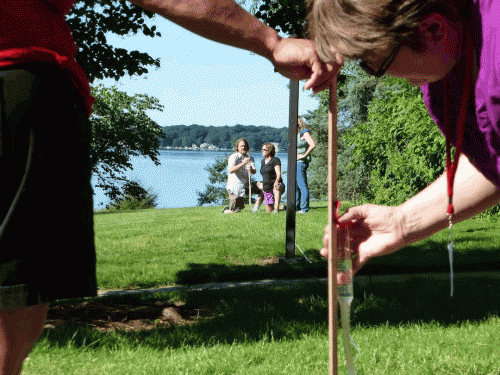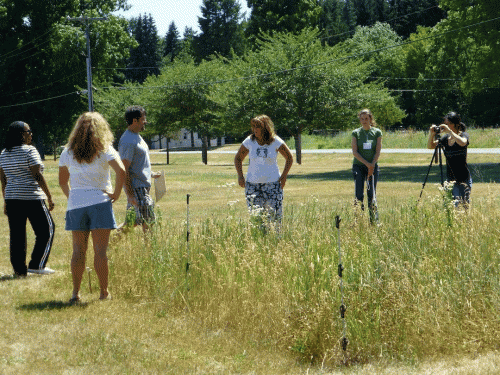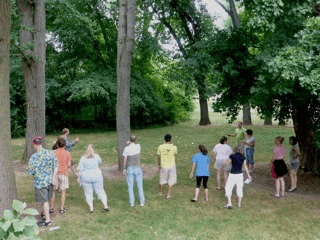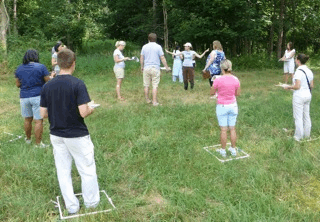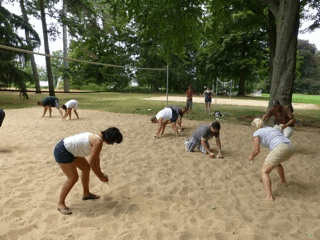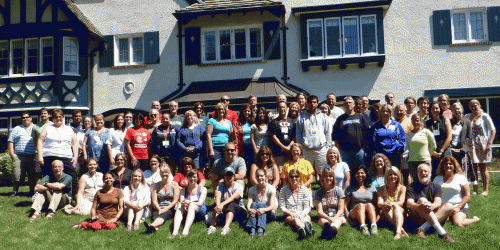By Guest Blogger and K-12 Partnership Volunteer Extraordinaire Joelyn DeLima
A magical week of making movies. That is the first thing that comes to mind when I describe the days from June 25th to 29th at KBS. The KBS K-12 Partnership Summer Science Institute was more than just sitting around learning science in input-driven sessions and discussions. This year the teachers, led by the returning fellows (Michael, Tomomi and Tyler), worked on preparing movies based on the three different sets of protocols that are conducted on our BEST Plots Research Network. The aim of this exercise was to prepare 60-75 second videos introducing the protocols in a manner that would spark a student’s interest. They could also be used as an overview for anyone interested in performing these protocols.
The entire endeavor, which took place on Monday afternoon and all day Tuesday, was loads of fun, but a bit challenging too. It kicked off with a short session in which the teachers were introduced to different techniques and methods of storyboarding. After a little practice, they were off to bring some glamour to the landscape, soil and biodiversity protocols. We saw some definite Oscar potential in direction and performances. The biggest difficulty was trying to fit everything into one minute!
Since this was a ‘Science Institute’ we did have some fun Science sessions too. The first plenary speaker was Dr. Sarah Roels from the University of Kansas. She spoke about her doctoral research on mating system evolution in a plant Mimulus guttatus. Over the course of her study, she measured traits of flowers from about 43,000 plants! She also did some cool experiments, including studying bee fidelity to flowers of different color intensity. She also measured the distance between anther and stigma in these flowers and concluded that as this distance decreased, the ability of these flowers to self pollinate increased up to 10 times. Dr. Roels was a good fit for our movie week too, as she worked with UV cameras in part of her research. She used these cameras to take UV photographs of the Mimulus flowers and observe the different patterns of pigmentation that we can’t see, but the pollinators can.
On Tuesday, Tom gave us an update on the “State of the BEST Plots”. Most of the plots were looking a bit brown due to the lack of rainfall this summer. Some had to be reseeded. Tom reminded us that the proposal for our BEST plots was rated to be ‘Outstanding in all respects’ by the NSF. Pretty soon we’ll start another year of data collection – let’s make the NSF proud!
On Wednesday, we heard from the GLBRC educator Leith Nye. He spoke for a short time but made quite an impact with a biodiesel-driven toy automobile. This was followed by the second plenary talk of the week, by our very own Dr. Jenny Dauer (Michigan State University). She spoke about her doctoral research as well, which dealt with calcium nutrition in forests of Oregon. In her talk she referred to calcium as the ‘the king of nutrients’ and ‘the soul of the soil’. Dr. Dauer spoke of nutrient cycling on multiple scales – from the molecular to the ecosystem scale.
After lunch on Wednesday were the MSP lead sessions. Jennifer and GK-12 Fellow Michael lead a session called Snakes on a Glade: Helping students understand the role of disturbance in shaping ecosystems. Using the case study of the giant Burmese Python, which is invasive in the Florida Everglades, they explored how students think about ecosystem disturbances. The great big attraction to this session was the great big python that they brought along!
At the same time, Jenny and Andy explored the question ‘How are inquiry investigations connected to student learning?’. In their session Fizz, burn and grow: Inquiry about Carbon, they conducted experiments that dealt with what happened to the carbon when soda water fizzes, ethanol burns and plants grow.
The elementary teachers meanwhile went on a tour. They first visited the historic Fort Schemske (site of the epic battle between Elaphines and Homo sapiens). While there they interacted with a number of researchers (including our own Liz Schultheis), who spoke about their work on various subjects including genetics, population ecology, invasive species and competition. The next stop on the tour was the LTER forest where the teachers learned about research being conducted on forest ecology.
MSP sessions continued on Thursday. In the morning, in Data analysis in the Biodiversity Leaf Pack Unit, Jennifer and first year Fellow Sara had teachers try new activities designed to tackle working with data in the MSP biodiversity unit. Teachers brought their laptops to the session and explored new Excel templates that will help make data analysis in the classroom easier.
The teachers also got to go to the beach and play with toy buckets and trowels. Marcia Angle (Teacher In Residence at KBS), Becky Drayton and Sara Syswerda conducted a session on Investigating Student Thinking About Watersheds. Aside from the play, they constructed a huge watershed model in the sand volleyball court to help students translate a 2-D depiction of a watershed into a 3-D representation.
It was field trip time again for the elementary teachers! The first stop on this tour was the Farming Systems Center. Bioenergy educator Dennis Penington met the teachers and spoke about Bioenergy in the US. Teachers had some great hands-on experience with the subject – they actually made biodiesel out of canola oil! The next stop was the Bird Sanctuary. Here the teachers explored the possibilities of using the newly opened Lake Loop Trail with their students.
One of the concurrent sessions on Thursday afternoon was Atoms are forever, Energy lasts forever: Carbon Students Accounts. Jenny and Andy built on their previous session. They used models, posters and an activity to think about what students really need in order to advance their understanding of carbon-transforming processes.
The Summer Institute also became a bit of a petting zoo. After the pythons on Wednesday, Thursday was bring-your-dog-to-the-institute-day! In Who Let the Dogs Out? Cheryl Hach, Debi Kilmartin and Liz Ratashak (with the help of Cheryl’s adorable dog) examined the relatedness of various dog breeds. They also explored current research involving the Dog Genome Project and health issues for dogs and their companions.
The afternoon field trips for the elementary teachers saw a few hardy souls brave 100-degree temperatures to go and visit the LTER research site. The group lead by Becky Drayton and LTER Education and Outreach Specialist Julie Doll went on a newly developed walking tour. After a lot of trial-and-error, they also helped Robin complete a part of the landscape protocols for the KBS BEST plots.
And thus we came to the last day of the eventful week. To begin the day we had our last plenary talk of the week. Julie Doll (KBS) spoke about Climate Change Communication. She started by relating her ‘Ah-ha!’ moment, when she saw firsthand the effects of climate change. Even though Climate Change is now widely accepted, the natural variability and the inability of scientists to make perfectly accurate predictions, creates a lot of contention in the minds of the public. This can be resolved by effective communication which should be tailored to the audience. She interspersed her talk with various questions for the audience and group discussions. Julie also followed the theme of the week and used a few videos (!) which could be used as conversation starters.
After the plenary, it was finally time for the new fellows to lead their first sessions, which they designed with the help of their partner teachers based on their own thesis research. Jake – whose interests include algal biofuel production was paired up with Russ Stolberg from Olivet. In their session A gas tank full of green! What’s lurking in Gull Lake and how it can power our vehicles, teachers took samples from Gull Lake. They observed the different types of phytoplankton present in those samples. The session also involved some input on deriving fuel from algae and a fun game in which the teachers lived a day in phytoplankton’s shoes.
New Fellow Cara is very interested in the aggression exhibited by house wrens. She and her partner teacher Meredith Hawkins led the session Angry Birds – Exploring behavioral trade-offs. They played a game in which they had to exhibit different levels of aggression in order to get the best ‘nesting sites’. The way they balanced the two factors affected how many offspring they were able to raise successfully. The session was made even more fun by having it at Lux Arbor and allowing the teachers to actually hold the baby wrens.
Cannibalism: Is it ever a good idea? was a session that was lead by 1st year Fellow Sara and her partner teacher Sandy Breitenbach. Sara is interested in the way tadpoles maximize their inclusive fitness by balancing cooperation and competition. Teachers collected data in a game that simulated different environmental conditions. They explored various strategies for survival, including cannibalism!
The flux and transformations of nutrients and organic matter in freshwater ecosystems, mainly streams and wetlands is what 1st year Fellow Dustin is interested in. He led the session – Groundwater: When water meets the surface – along with his partner teacher Marty Green. They discussed what happens to surface water once it enters the subsurface. Part of their session was conducted at Augusta Creek where they taught teachers to locate sites of groundwater discharge. They also analyzed samples of well water brought in by the teachers from their own homes.
The highlight of the day, though, was the last session. After hours of laborious editing, the BEST Research Network movies were finally ready to view. We munched on popcorn and enjoyed the movies and many, many laughs! Thanks for another great Summer Science Institute.

